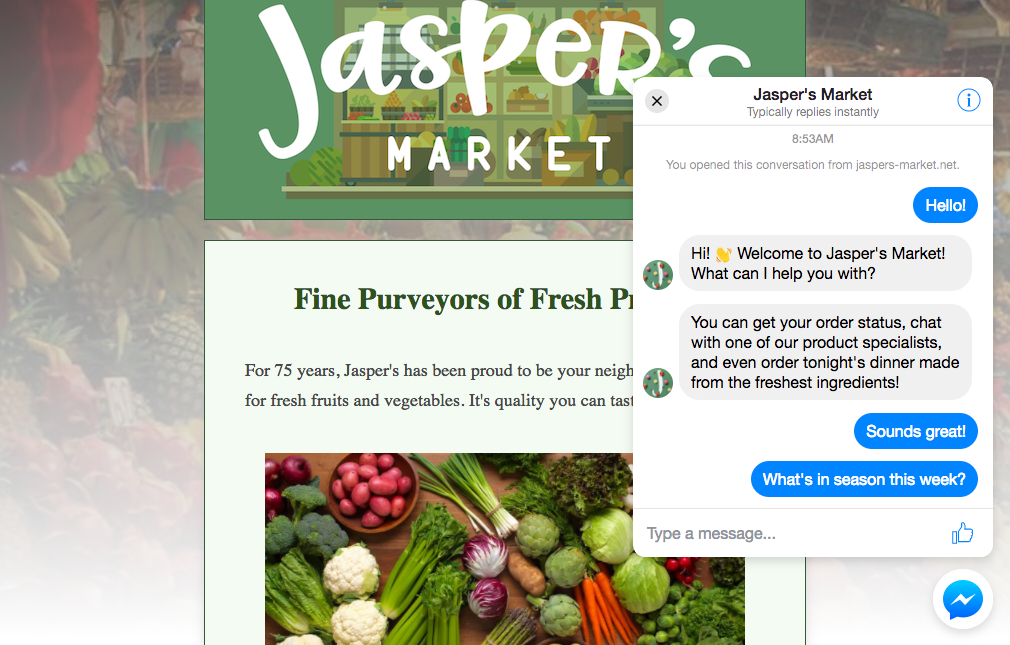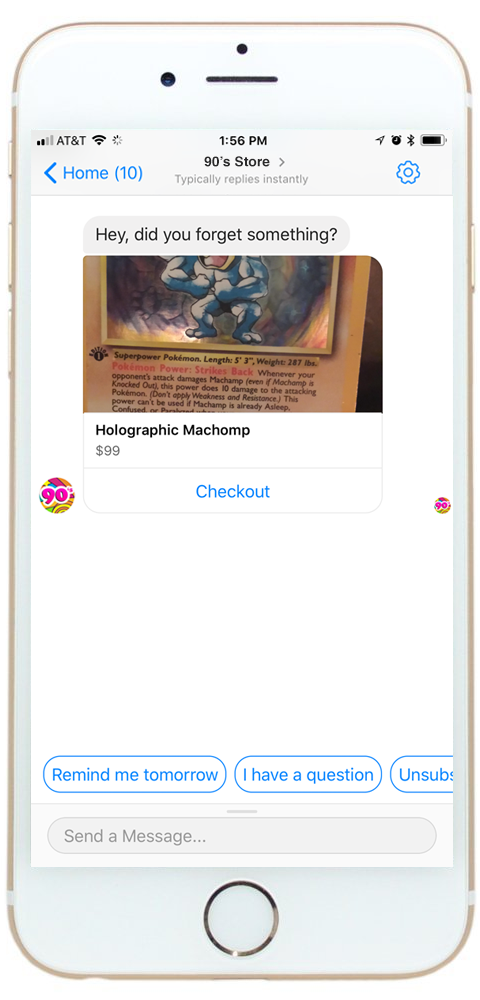The Complete Guide to Conversational Commerce
Examples of Chat-Based Conversational Commerce
These are a few examples of chat-based conversational commerce. (“I’m looking for voice based examples, Matt!” well alrighty, I hear ya, just scroll down a bit more to see the voice examples!)
“Talking to virtual employees will play an increasingly pivotal role: customers don’t want to wait for answers to simple questions. And business don’t want to allocate resources to answer the same questions over and over.” —Phil Vanstone, Program Manager at Shopify Plus
Index of chat-based conversational commerce examples:
- Seamlessly connect with the customer on Facebook Messenger.
- Chat with the customer directly from the online store.
- Touch base with the customer after they leave the store.
- Let the customer know that their order has been made.
- Let the customer know that their order has shipped.
- Thank the customer after their first purchase.
- Confirm with the customer that their package arrived and ask for their opinion.
- Recommend products based on purchase history and customer data that’s been collected conversationally.
- Ask the customer if they are ready to reorder a replenishable product.
- Troubleshooting.
- Answer a question.

Seamlessly Connect With the Customer on Facebook Messenger
The first thing you are probably wondering is, “How the heck do I message my customers on Facebook?”, the answer is quite simple: You need to implement the Facebook Messenger Checkbox.

What does the checkbox do? Here is the high-level explanation:
- The checkbox automatically detects a customer’s Facebook profile when they view your store, even if it is the first time they have ever been there.
- Stores place the checkbox next to the “Add to cart” buttons on product pages or during the checkout confirmation screen.
- Customers who go through a flow involving the checkbox are able to give the store permission to send them future messages on Facebook.
- Once the store has permission to send messages to the customer on Facebook, the store can start to send conversational experiences when they are trigged during the customer journey (like sending a message when a customer doesn’t complete an order).


Most stores currently collect email addresses during the checkout process, meaning that most shoppers who add an item to their cart are never connected over email with the store.
An implementation of the Facebook Messenger Checkbox moves the ability to connect with a customer to the top of the funnel. You have the potential to increase the number of customers you can talk to by 2–5x.

Chat With the Customer Directly From the Online Store
When someone walks into your physical store, they can ask you questions, point out products, tell you about what they are looking for, etc., and an employee at the store can help in real time.
How do you provide this same level of service for customers shopping online? By installing an automated on-site live chat.
“Integrating chatbots can dramatically enhance the pre and post sales customer experience. For the ecommerce store owner, she can free up time by delegating repetitive FAQs and product questions, for example, to the automated chat system.” — Mari Smith, Facebook Marketing Expert and Author of The New Relationship Marketing
If you’ve never seen one before, this is what it looks like:


You can personalize the chat experience to send the customer messages based on multiple data points, like their purchase history or what product they are currently looking at.
By using conversational commerce, you can automate conversations about questions, deals, and product discovery, helping the customer throughout their journey.


“But Matt! What if they need to talk to a human?!” Great question my dear reader! In this situation the customer can automatically be connected to a human support agent or directed towards a phone number or email where they can get in touch with a real person to solve more advanced inquiries.

Touch Base With The Customer After They Leave The Store
When a customer adds a product to their cart and then doesn’t complete the purchase, the store can send a private message 1–4 hours later to the customer asking if they would like to complete their purchase or if they have any questions.


By using the Facebook Messenger Checkbox, and an abandoned cart conversational commerce experience, stores have already started increase revenue by 7–25%.

Let The Customer Know That Their Order Has Been Made
Making sure that the customer knows the status of the order is important. After spending money online, customers want to know that the order was made and that it will be shipped soon.
“Virtual employees will likely become essential on the eCommerce front lines as companies scale and become more global, when around-the-clock assistance, multi-language fluency and deep product, pricing, and inventory intelligence will be expected by consumers worldwide, on demand.” — Tomer Tagrin, CEO of Yotpo
By sending customers messages on conversational platforms like Facebook Messenger, you can keep them in the loop and enable them to request future notifications related to their order.



Let The Customer Know That Their Order Has Shipped
Similar to the order confirmation message, the shipping message keeps the customer in the loop and reduces the amount of times they will need to ask a human at the store for the status of their order.



Thank the Customer After Their First Purchase
After a person has completed their first purchase at a store, it is a good idea for the store to send out a personal note thanking them for their business.
“Fundamentally, email is a channel that brings people back to the website or app to complete the user experience. However, chatbots and voicebots present new user flows that can be potentially handled natively. It’s very likely you will be able to complete an order, provide payment or authorization without ever going to the website or app. This is where chatbot and voicebots will go beyond the capabilities of email and make the user experience not only more efficient, but almost magical.” — Joseph Hsieh, Ecommerce Advisor
Doing this over conversational platforms enables the interaction to be more personable and meaningful than over email. Not only does the language sound natural, similar to how a friend or family member would talk to you, but it enables the relationship to immediately strengthen by allowing the customer to continue the conversation.



Confirm With The Customer That Their Package Arrived and Ask For Their Opinion
This message can be sent after the package has been detected as delivered, or an estimated 14 days after an order has been made (depending on which data is available to the store).
Stores can collect data such as:
- Satisfaction with the product on a scale of 1 to 5.
- Detailed written review of the product.
- Pictures or videos of the customer using the product.



Recommend Products Based on Purchase History and Customer Data That’s Been Collected Conversationaly
If a customer walks into a store, they can get help from an employee. They can tell them what they are looking for, their preferences, the purpose of the purchase, etc.
Replicating this type of experience online hasn’t been as straightforward, especially over platforms like email.
Conversational commerce makes this very easy. Instead of just getting sent recommendations based on what is trending, stores can message customers questions that enable them to make very precise recommendations.



Help Reorder a Replenishable Product
There are certain types of products that customers will want to purchase over and over again, things like: hand lotion, face cream, food, and paper towels.
Using customer data related to each of these items, it is possible to predict how long it takes someone to consume a good, and then automatically send them a message asking if they need to reorder that item.
This is helpful for the customer and the business.



Troubleshooting
It is common for a customer to have questions about a product they recently purchased.
- “Can I wash this in cold water?”
- “How do I shoot wide angle video?”
- “It won’t turn on, what do I do?”
Instead of requiring a person at the store to manually answer each of these questions, conversational commerce can be used to automatically detect the question and immediately respond with the correct answer or guidance.



Answer a Question
When a person walks into a store to look at a product, they have the ability to ask an employee questions.
- “Does this come in a small?”
- “Can this camera go underwater?”
- “Do you carry red shoes?”
Stores can use conversational commerce to answer this pre-purchase questions.
“[I think virtual employee’s, like chatbots and voicebots will play an important role in the future of ecommerce] because the product questions are usually the same ones over and over, which is a core use case for chatbots.” — Larry Kim, CEO of Mobile Monkey and Columnist at Inc and CNBC



“But Matt! Show me the voice examples!”
Yes, great idea! Let’s do that right now.
Scroll down to see conversational commerce examples for voice platforms.
